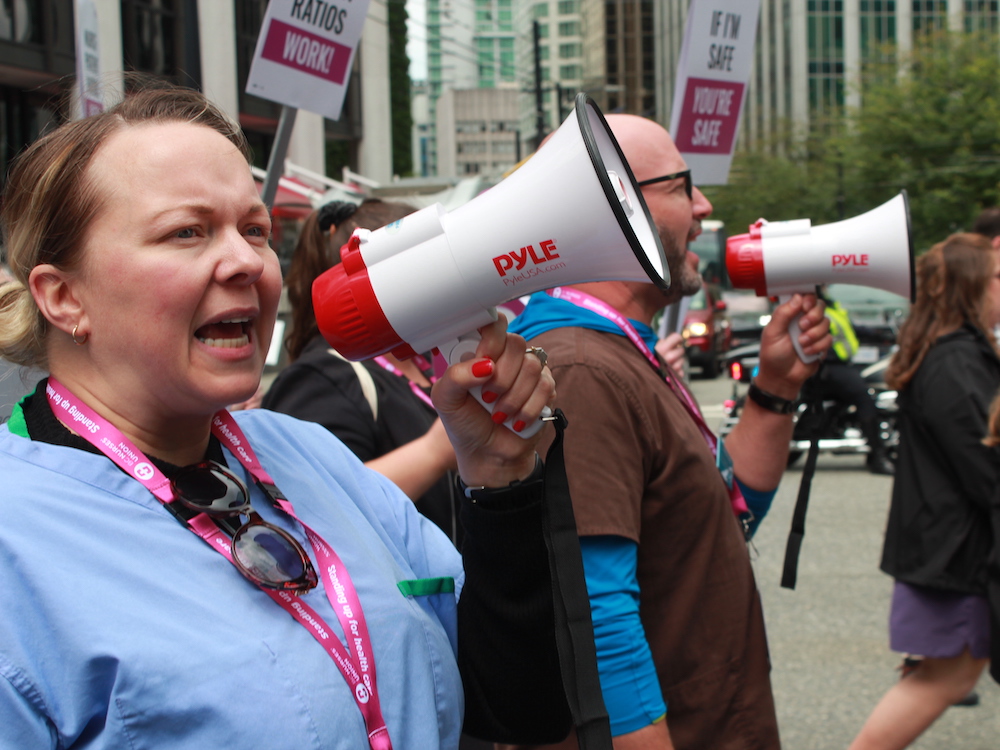British Columbia is introducing minimum nurse-to-patient ratios for its hospitals.
This is part of a strategy to recruit, retain and return nurses to work and improve health and safety and health outcomes for nurses and patients, says Health Minister Adrian Dix.
It is “vital work” because B.C.’s population is growing and aging, which means more pressure on the health-care system, Dix said in announcing the measures Friday.
Last year B.C. added a net 6,567 nurses, but over the last three years it also added 542,000 people to its Medical Services Plan. Across the province this week there are 10,300 people in hospital, which Dix said is hundreds more people than last year and around 550 more people than four years ago.
Dix attributes this increase to an aging, growing population. But Paul Kershaw, founder of the University of British Columbia’s Generation Squeeze think tank, says the increase is also in part due to the fact that the province is not investing enough in the social determinants of health — meaning more people are likely to get sick and need acute care.
Guaranteed minimum nurse-to-patient ratios are a good way to improve patient care in B.C., says Adriane Gear, BC Nurses’ Union president.
“Evidence shows ratios save lives, reduce patient mortality, improve outcomes for patients, reduce the length of stay in hospital, reduce readmission rates and improve the overall patient experience,” Gear said.
Australia and California also have nurse-to-patient ratio rules in place. The policy has been shown to save lives and improve the experience for nurses and patients alike, according to B.C.’s Ministry of Health.
Intensive care will have one nurse for each patient around the clock every day. High acuity wards will have one nurse per two patients, and focused and palliative care will have one nurse per three patients. General medical and surgical inpatients will have one nurse per four patients, and rehabilitation will have one nurse per five patients during the daytime and one nurse per seven patients at night.
Dix says these ratios will start being implemented by this fall.
The ratios were first announced in April when the Nurses’ Bargaining Association and the Ministry of Health signed an agreement to support nursing in B.C. by adopting minimum nurse-to-patient ratios. The association bargains on behalf of 52,000 nurses from four unions, though mainly from the BCNU.
It took almost a year to decide what some of those ratios would be because the ministry wanted to collaborate with the BCNU rather than impose its own vision, Dix said.
The ministry is expected to announce ratios for the remainder of hospital settings, non-hospital settings including community settings and long-term care and assisted living by June.
Meena Brisard, spokesperson for the Hospital Employees’ Union, said in a statement that the ratios will help strengthen B.C.’s health-care system. But she also urged the government to implement similar staffing models for care aides and others who help care for seniors.
The statement also called on the BC NDP to “restore the standard wages, benefits and working conditions that had been dismantled by the previous BC Liberal government.”
The ministry has committed $237.6 million to recruit, retain, train and return nurses to work.
The bulk of the funding is earmarked for retention, with $100 million going towards the Nurse Support Fund, including funding for mental wellness support of nurses.
A little less than 30 per cent of that will be spent on helping nurses with training and licensing, for example with bursaries and a $2,000 tuition credit for those pursuing a bachelor of science in nursing, bachelor of psychiatric nursing or practical nursing. Indigenous students will get an additional $5,000 tuition credit for the same programs.
Just over 20 per cent will be spent on recruiting nurses and bringing nurses back to work, with bonuses for nurses who fill rural and remote vacancies.
When asked why B.C. is offering bonuses rather than higher pay for nurses in remote and rural communities, Dix said these incentives have been shown to work.
Last year B.C. hired 6,567 net new nurses, and in 2023-24, B.C. post-secondary institutions graduated around 1,500 registered nurses, 120 registered psychiatric nurses and 500 licensed practical nurses, according to the health minister.
B.C. is leading Canada in expanding its nursing workforce, Dix said.
Despite that, “it’s never been a more challenging time to be a nurse in B.C.,” Dix said. “We’re doing better than other provinces but not well enough for nurses and patients.”
Dix added it’s his goal to “make B.C. the best place to be a nurse in the world.”
The Tyee asked the BC Nurses’ Union how many staffing vacancies the new ratios are expected to create but did not hear back by press time. ![]()
Read more: Health, Labour + Industry, BC Politics

















Tyee Commenting Guidelines
Comments that violate guidelines risk being deleted, and violations may result in a temporary or permanent user ban. Maintain the spirit of good conversation to stay in the discussion and be patient with moderators. Comments are reviewed regularly but not in real time.
Do:
Do not: